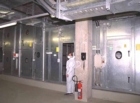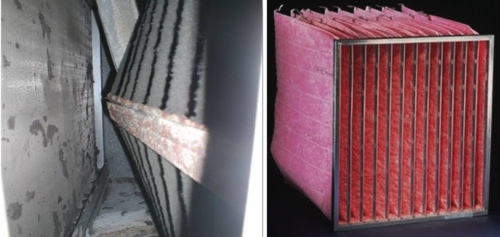Filtering out energy costs

Are you tempted by a 3-month payback on an energy-saving investment. Upgrading filters in plant such as air-handling units has that potential, as Peter Dyment explains.
Given the durability of public and commercial buildings — 80% of existing commercial and public buildings will still be in use in 20 years’ time —most of the short-term energy-efficiency measures now needed will be made to existing buildings and their heating, ventilating and air-conditioning plant.
The Government is using the compliance inspection of existing air-conditioning plant to help flag up worthwhile measures. The CRC Energy Efficiency Scheme is another driver to make energy savings. In the end, however, rising energy costs will directly force action on users.
There are two main ways to save energy and money with air-handling plant. One is to turn off the air-handling unit or turn it down as much as possible when it is not needed. The other way is to optimise performance of all the energy-using components as much as possible; low-energy air filters offer a great opportunity here.
You can pay as much as £500 for the energy typically used by one F7 class bag filter each year, so it is worth making sure they are giving value-for-money performance.
When you select a low-energy air filter, this energy cost can be reduced to only about £200 pounds a year because of the lower average pressure drop.
That saving of £300 in annual energy costs per full-size filter is made possible by a filter that typically costs only £30 more.
Optimised selection of air filters in the air-handling units of air-conditioning systems is very cost effective. The payback time can as short as three months — even less for a plant that runs for long hours. That is a very short payback indeed compared with other commonly suggested options. For example upgrading the fans of AHUs or chiller upgrades can have a payback time of two to three years or even longer.
The current economic climate means that short payback times and energy-efficiency measured at can be implemented for low or no cost are the best place to start. Basic maintenance checks such as making sure the intake grilles are clear of leaves and feathers can save hundreds of pounds a year in energy. Anything to reduce air resistance through ducting and AHUs should be considered.
Low-energy air filters have an extended media surface area which gives a low pressure drop at the rated airflow for the filter. The air resistance or pressure drop is directly related to the energy consumed. It is possible to select an F7 bag filter that only has 40% of the pressure drop of some budget-cost F7 air filters.
Experience shows that older AHUs are often well proportioned in terms of plenum length and cross-section but often fitted with poorly sealing side-withdrawal (SWF) mounting frames for the second-stage fine filters.

European standard EN 13779:2007 covers indoor air quality and advises F7 to F9 class filters (tested to EN779:2002) should be fitted for clean supply air in the building. Front-withdrawal mounting frames (FWF) for the filters are necessary to give a good air seal and prevent the bypass of dirt-laden unfiltered air.
The best solution is to replace SWF with FWF and use low-energy air filters. An added benefit is that standard full-sized filters can be used exclusively in the process.
The main function of an HVAC air filter is to clean the air supplied to a building so that occupants can inhale it without risk to health.
The next function is to maintain plant efficiency. This can be done by keeping the coils and other heat exchangers clean to avoid deposited dust increasing pressure drop across them and other components that are susceptible to clogging. The air filter needs to be positioned upstream of any coil and heat-exchanger surfaces to preserve their heat-transfer efficiency.
A major benefit of an F7 12-pocket low-energy air filter is that its high media capacity enables it to be used as a single-stage filter system. This is a benefit unique to this filter and allows a substantial reduction in energy use. It also has media with a consistently high particulate efficiency throughout its working life. It needs to be mounted in a front-withdrawal mounting frame to stop possible air bypass.
Once the opportunity of refurbishing an air-handling unit has been identified, using low-energy air filters can form the basis of a package of energy-saving measures such as coil and duct cleaning that will reduce the base pressure drop of the air-conditioning system. Checking for other possible obstructions such as jammed dampers is always worthwhile.
Additional large amounts of energy can usually be saved by checking the volume flow rate of the system and re-commissioning it to suit the current use. This approach, while not glamorous, never fails to yield significant results.
Peter Dyment is technical manager for Camfil Ltd







